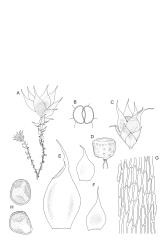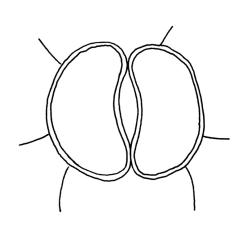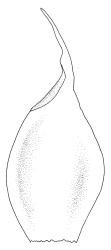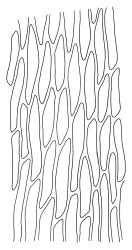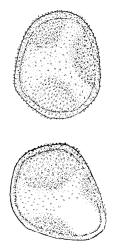- ≡ Anictangium repens Hook., Musci Exot. 2, 106 (1819)
- ≡ Leptangium repens (Hook.) Mitt., J. Proc. Linn. Soc., Bot. 4: 79 (1859)
As per the genus. Laminal cells mostly 90–115 × 18–24 µm in N.Z. material.
Setae c. 0.2 mm. Spores 150–190 µm in N.Z. material.
Scott & Stone 1976, pl. 47; Fife 1994, fig. 316; Meagher & Fuhrer 2003, p. 100–101; Seppelt et al. (2012), fig. 1, 4–6 (Fig. 1 is reproduced in Seppelt et al. (2013), pl. 6).
NI: Hawke's Bay (Raukawa Range, Maraetōtara River); Wellington ("Ruahine Limestone Plateau"); SI: Canterbury (Marble Point, Napenape, Ōtāhuna Valley), Otago (Ōamaru, Duntroon, Roxburgh); Ch (near Maunganui Bluff).
Anomalous. Tasmania*, Australia*, South Africa*, Mexico*.
On mineral soil, usually over limestone or marble bedrock; also on base-rich clays (presumably derived from volcanic rock). The plants are perennial with fleshy subterranean rhizomes. Occurring from near sea level (Napenape) to at least 360 m (Duntroon). On Chatham I. it grew on "bare, very hard, desiccated basaltic clay under a huge over-hanging, north-facing basalt boulder" (P.J. de Lange, pers. comm., 11 Oct. 2007).
The first N.Z. collection of G. repens in N.Z. was made by Colenso in 1850 (W. Colenso 1439, BM!). This ample collection was not cited by Wilson (1854), but formed the basis of the report of this species (as Leptangium repens) from the Raukawa Range in Hooker (1867, p. 424). Antheridia can be surprisingly difficult to detect, given that the species fruits abundantly. Although there is some disagreement in the literature as to sexuality of G. repens, N.Z. material is unquestionably autoicous, as is at least some foreign material. Antheridia have been observed in material from Roxburgh (W. Martin s.n., CHR 566139 A). Autoicous plants have been seen also from Western Australia and South Africa. Most commonly, the perigonia are terminal on erect male shoots that are connected to female shoots via the rhizome. However, antheridia can also occur on short lateral branches (c. 2–3 mm below a perichaetium), among sessile whorls of unmodified leaves, or in the axils of vegetative leaves on perichaetial shoots.
Scott & Stone’s (1976, p. 252) statement implying that Australian material is dioicous is probably based on incorrect observations. My earlier (Fife 1994, p. 423) statement that Mexican material of G. repens is "apparently dioicous" is likely incorrect but I have been unable to re-examine the Mexican collection.
Seppelt et al. (2012) discussed the ecology and phenology of G. repens in Tasmania. They detailed both its Tasmanian and mainland Australian distribution and discussed these in relation to rainfall patterns, geology, and collection history. They postulated a perennial habit with summer die-back of above-ground shoots and also speculated that long-standing agricultural practices including fertilizer application have likely reduced the range of G. repens in central Tasmania.




